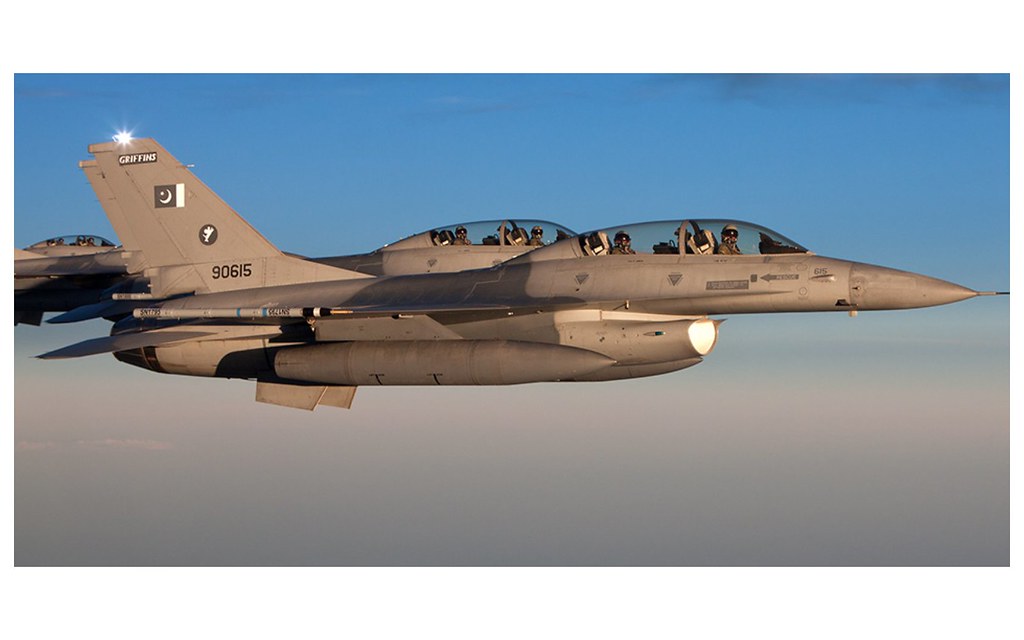Scorching Red Flag
The latest Red Flag Exercise at Nellis AFB was a classic, notable for some very rare participants. Paul Filmer braved the searing desert to witness the action.
Combat Aircraft Monthly October 2010.
Red Flag 10-4 took place at Nellis AFB, Neveda, from July 19-30 and included for the first time, the Pakistan AF with a contingent of F-16Bs. In fact, this was the very first time that the Pakistan AF has been involved in any exercise in the US. The aircraft present at Red Flag were all from No.9 Squadron Griffins based at PAF Mushaf in the small city of Sargodha.
The Pakistani contingent flew to Nellis AFB via Lejas Field in the Azores, where the USAF 65th Operations Support Squadron hosted them during the stopover. All the pilots were well trained in advance for the long trans-Atlantic crossing. Six aircraft were brought to Nellis and during the first seven days, two sorties with four aircraft were flown each day. Surprisingly one of the airframes did not fly at all and one other flew just one mission, so the remaining four jets were used almost exclusively --- a testament to the reliability of the aircraft despite their age. Along with the aircraft, around 100 support personnel travelled from Pakistan to Nellis, staying on after Red Flag to participate in Green Flag.
The Pakistan AF Vipers were two-seat Block 15 machines and were part of the final production run of 40 F-16Bs. They were handed over in the early 1980s and after initial aircrew training at Hill AFB, Utah, were delivered to Pakistan between 1983 and 1986. US embargoes placed in 1990 would mean that parts and support would dry up, but the ever resourceful Pakistan AF kept its Western equipment flying. However, the embargo, the Pressler Amendment also cancelled 71 newer F-16s that had already been ordered, and the completed airframes ended up in AMARC (Aircraft Maintenance and Regeneration Center), before being distributed to the USAF and US Navy. This embargo has since been lifted and new Block 52 F-16C/D models have started to arrive along with upgrades for original examples. During 2007-08, the 14 examples distributed to the USAF have since been handed over to the Pakistan AF. Similarly the 14 examples distributed to the US Navy remain in service with the navy.
Pakistani Vipers on Red Flag Gp-Capt. Javed Saeed, Red Flag Detachment Commander.
What does participation in the Red Flag mean to the Pakistan AF?
The Pakistan AF has been a regular participant in various inland as well as foreign multi-national exercises. Red Flag, however, has been unique in comparison in many regards. The deployment from home base to Nellis in itself was a unique experience considering the distance and the consequential use of aerial refueling. The Pakistan AF stands on the verge of modernization for which the Red Flag offers a credible training environment for the benefit of its participants.
Back in 2006, fighters from the USAFs 77th Fighter Squadron were deployed to Pakistan for Falcon Talon. Did any of the Pakistan AF members participate in that? What does this exercise mean in relation?
Coincidently, all of the present aircrew of the Pakistan AF contingent did not participant in Falcon Talon 2006. However, was not flown on such a large scale as far as the number of aircraft as well as the variety of roles they were employed in is concerned. The use of force-multipliers as well as a comprehensive simulation of enemy IADS (Integrated air-defense systems) is another aspect that Falcon Talon lacked in comparison to Red Flag.
How has this exercise helped so far?
Red Flag has given the Pakistan AF the opportunity to deploy its assets and personnel halfway around the world. It has also provided a contemporary air combat training environment for our less experienced aircrews.
What effects does this exercise have on US-Pakistan relations, both military and non-military?
Red Flag gave both nations an opportunity to understand each other better culturally and professionally. Both aspects are crucial for forces and nations dependent on each other when working for common objectives. For the Pakistan AF, to participate in Red Flag required training and proficiency on air-to-air refueling operations. With USAF support, the Pakistan AF was able to gain that proficiency prior to Red Flag deployment.
What does it mean for the contingent to have crossed the Atlantic?
Crossing the Atlantic has a certain symbolic importance attached to it. Our maintenance did a wonderful job making sure our aircraft were in good shape throughout the deployment, especially for the transatlantic leg. The pilots were trained well and prepared even better to make them comfortable crossing the vastness of the Atlantic.
How have US-Pakistan relations developed since Falcon Talon 2006?
Falcon Talon was the first joint exercise between the Pakistan AF and USAF in a long while. The enhanced mutual respect and appreciation for one another led to a second Falcon Talon in 2009 and now to Red Flag.
How has it been to work with the other countries here?
Every nation and its service has its individuality as a result of the subtle differences in their way of operations. The opportunity to interact and operate in a joint environment allows for collective improvement by learning from the strengths of others.
Have any members of the Pakistan contingent trained in the US before?
From 2003 onwards a number of Pakistan AF pilots have gone through IFF (Introduction to Fighter Fundamentals) training here in the US. Recently eight of our pilots received training for the Block 52 F-16s with the Tucson ANG. Red Flag however, is the first major exercise in which the Pakistan AF has had the opportunity to participate in the US.

















